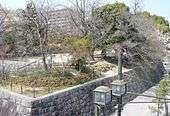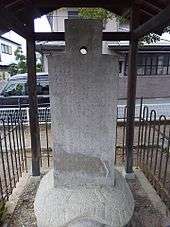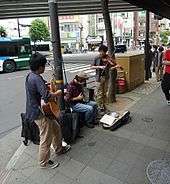Itami, Hyōgo
| Itami 伊丹市 | |||
|---|---|---|---|
| City | |||
| |||
 Location of Itami in Hyōgo Prefecture | |||
 Itami Location in Japan | |||
| Coordinates: 34°47′N 135°24′E / 34.783°N 135.400°ECoordinates: 34°47′N 135°24′E / 34.783°N 135.400°E | |||
| Country | Japan | ||
| Region | Kansai | ||
| Prefecture | Hyōgo Prefecture | ||
| Government | |||
| • Mayor | Yasuyuki Fujiwara | ||
| Area | |||
| • Total | 24.97 km2 (9.64 sq mi) | ||
| Population (May 1, 2017) | |||
| • Total | 196,767 | ||
| • Density | 7,900/km2 (20,000/sq mi) | ||
| Symbols | |||
| • Flower | Azalea | ||
| • Bird | Duck | ||
| Time zone | Japan Standard Time (UTC+9) | ||
| City hall address |
1-1 Senzo, Itami-shi, Hyōgo-ken 664-8503 | ||
| Website |
www | ||
Itami (伊丹市 Itami-shi) is a city located in Hyōgo Prefecture, Japan. As of May 2017, the city had an estimated population of 196,767 and a population density of 7,900 persons per km².[1] The total area is 24.97 km². Itami sits on the Hankyu Railway Itami Line and the JR Takarazuka Line (Fukuchiyama Line).
History
The hilly area is called the Itami plateau, between the Ina River and the Muko River in the southeastern part of Hyogo Prefecture. Rice cultivation was done in the area from ancient times.
It is called "Inano", from the southern part of Itami city to the north part of Amagasaki, there are burial mound group such as "Gogazuka-kofun(ancient tomb) " and "Kashiwagi-kofun" burial mound which was built during the Kofun period. Many "WAKA (Japanese poem)" that wrote "Inano" in the Waka collection woven from the Nara period to the Heian period. Waka written by Daini no Sanmi (大弐三位) is most famous. In the northern part of Itami city, there is a historical site of Buddhist temple "Itami Ruined Temple Site" from the Nara period to the Kamakura period.
The center of Itami became a wealthy town by the middle of Sengoku period. It was named Itami-go (town of Itami) and known as the only Japanese town within a castle (usually Japanese castles were located far from domestic areas). Itami-go was a part of Castle Arioka which Araki Murashige ruled under Oda Nobunaga. After the uprising and defeat of Araki, the castle was torn down.
Today's city was established on 10 November 1940. Great portions of the city were damaged in the Great Hanshin–Awaji earthquake of 1995, but were quickly rebuilt.
Most of Osaka International Airport is located in Itami (hence the common name "Itami Airport"): it is Osaka's primary domestic airport, although all international flights and many domestic flights shifted to Kansai International Airport in 1994. Despite the airport's association with Itami, the terminal complex in truth sits in the neighboring city of Toyonaka, and the Itami city center is connected to the airport only by a long tunnel that passes beneath the runway and tarmac.
The city is also famous for Koyaike Park, which features a large model of the Japanese archipelago set in a circular pond. The park is a frequent sight for passengers on flights into Itami Airport. Moreover, Itami is one of the important sake-brewing cities in Japan. Some historians claimed Itami was the place where seishu, clear sake, was invented.
Geography
Itami City is located in the southeast of Hyogo Prefecture, with the Ina River east and the Mukogawa River west. The city area is a flat, undulating gentle terrain throughout. JR West Japan Fukuchiyama Line (JR Takarazuka Line) and Hankyu Itami Line traverse north and south. It is close to about 10 km from Osaka city, contacts Kawanishi City in the north, Takarazuka City in the north and west, Nishinomiya City, Amagasaki City in the South and West, Osaka Prefecture Ikeda City, Toyonaka City in the east. In Hyogo Prefecture, the population density is the second highest following Amagasaki City in the south neighbor.
Industry
The history of "sake" brewing in Itami district is very old, and "sake" brewing has been done since the Muromachi period.In the Itami area, people discovered a way to brew clear and colorless Japanese rise wine, now known as "sake". In the Edo Period of Japan, the "sake" brewed in Itami enjoyed tremendous popularity. Now sake is still contributing to the prosperity in the Itami area.
Education
There is a North Korean school in Itami, Itami Korean Elementary School (伊丹朝鮮初級学校).[2]
City Natives
Japanese singer, songwriter Masami Okui was born in Itami.
Sister cities
Culture and regular events
- Itami Machinakanaka Bar -It is an event,eating and drinking and walking, in the city center of Itami city. It held twice a year(in spring and autumn). You can also enjoy music played by street musicians.
- Nakumushi to Go-cho - "Insect hearing" is a Japanese poetry of autumn. In the center area of Itami city, the "insect hearing" event is held every September. At this event, various events related to "insect hearing", such as music concerts, study sessions, reading books, workshops, etc, during a few weeks period.
Sport, leisure and tourism

- Inano-shrine 猪名野神社
- Koya-temple 昆陽寺
- Itami Castle Ruins (Arioka Castle Ruins) 伊丹城址(有岡城址)
- Koyoike Park 昆陽池公園
- Itami Sky Park 伊丹スカイパーク
- Aramaki rose park 荒牧バラ公園
- Miyamena Cultural Towns Itami-shi Itami-cho Town Pavilion, Town Old Okada Family with Sake Brewery (Important Cultural Property of the Country) みやのまえ文化の郷
- Kakimori-Buko 柿衞文庫 One of the three great haikai papers in Japan.
- Itami City Library 伊丹市立図書館
- Itami City Museum of Art 伊丹市立美術館
- Itami City Museum of Insects 伊丹市昆虫館
- Gogazuka-kohun ( Ancient tomb ) 御願塚古墳
Notable people
- Uejima Onitsura, Japanese haiku poet of the Edo period
- Aiko Uemura, mogul skier
- Akira Ueda, voice actor
- Hayato Sakamoto, baseball player
- Hiroyuki Nakajima, baseball player
- Katsuki Yamazaki, baseball player
- Masahiro Tanaka, baseball player
- Masami Okui, singer
- Yoko Minamino, actress
- Kasumi Arimura, actress
References
- ↑ "Official website of Itami City" (in Japanese). Japan: Itami City. Retrieved 13 May 2017.
- ↑ "ウリハッキョ一覧" (Archive). Chongryon. Retrieved on October 14, 2015.
- ↑ "TID Travel Journal "Itami City: Dream and Fascination"". Hyogo Tourism Association. Retrieved April 2, 2015.
- ↑ Dr. Katsuhiro Sasuga (28 October 2004). Microregionalism and Governance in East Asia. Routledge. p. 144. ISBN 0-415-33134-X.
External links
| Wikimedia Commons has media related to Itami, Hyogo. |




